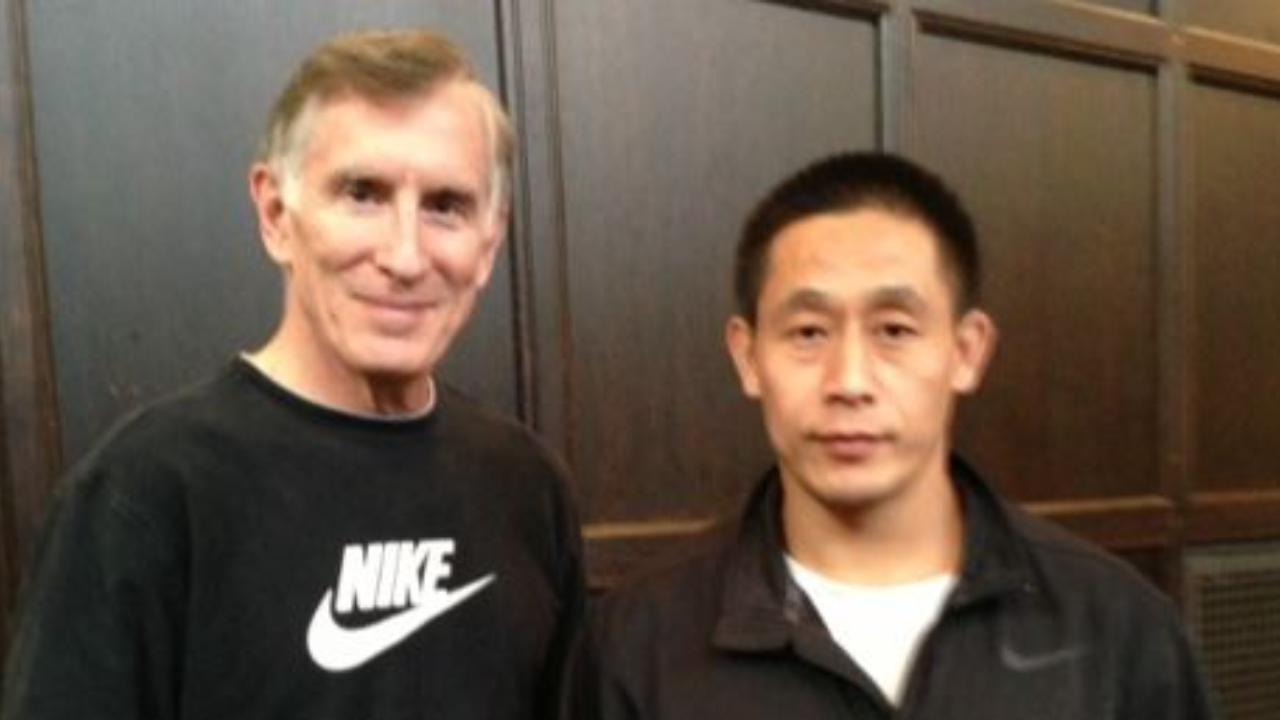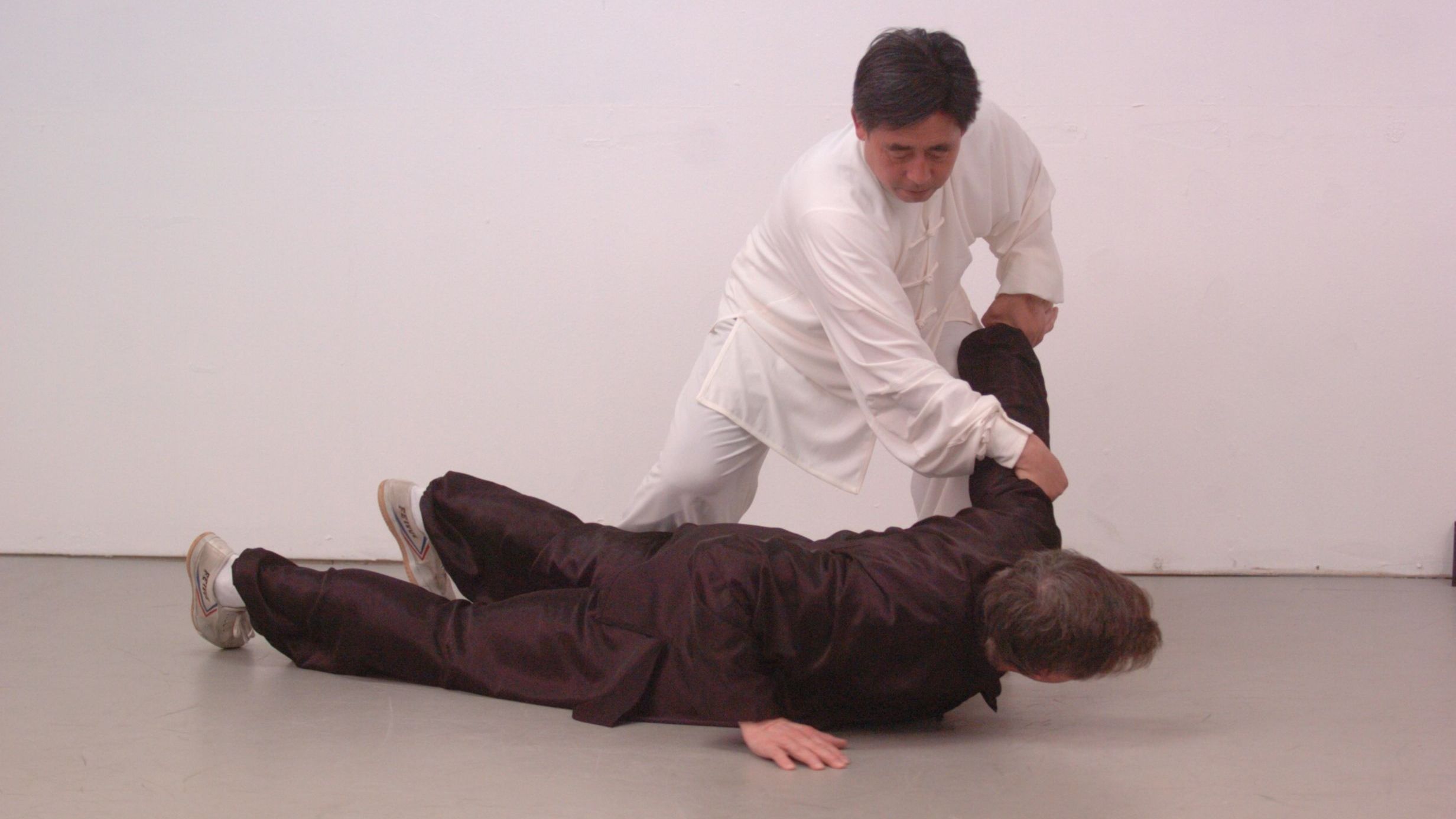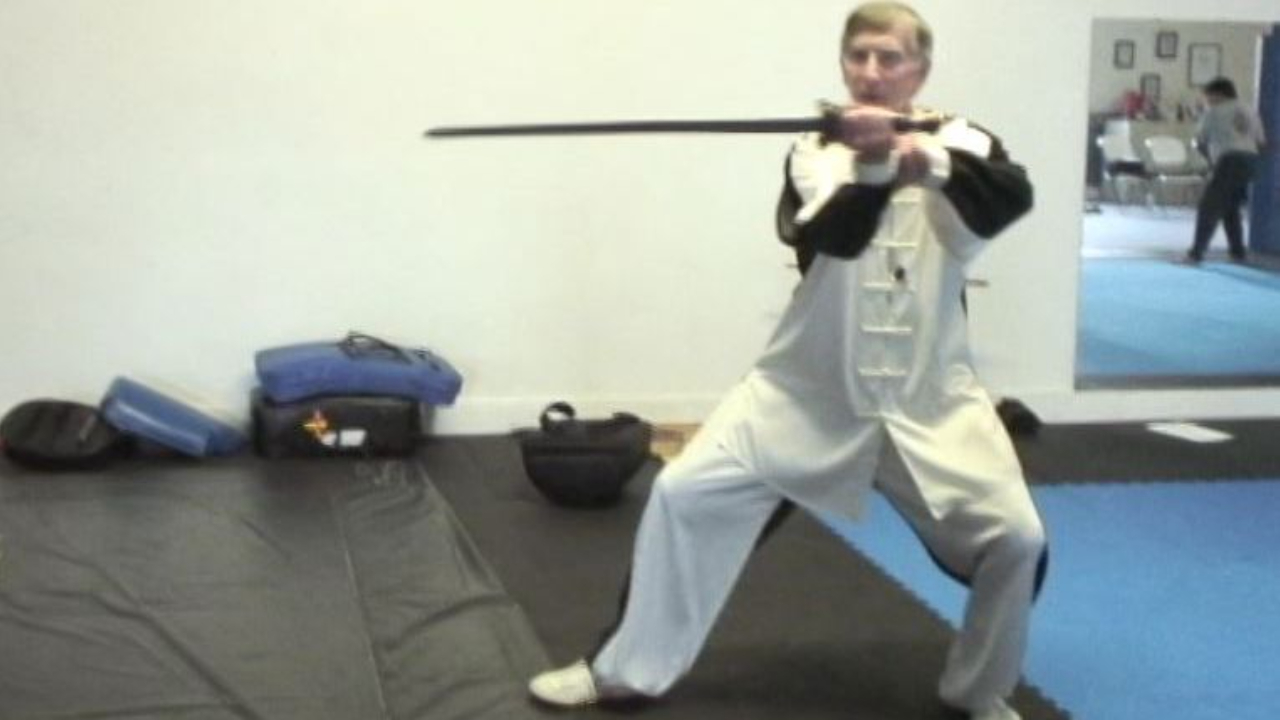Chen Ziqiang and the Fighting Applications of Push Hands

I've been looking for an opportunity to attend a workshop on push hands applications with Chen Ziqiang for several years. They play rough in the Chenjiagou Taiji School, where he is vice-principal and head coach, and I have heard of his reputation as a tough guy for about 9 years. The recent TV broadcasts of some of his sanshou matches were tutorials on effective Taiji fighting principals. What I appreciate most is his ability to "bump" an opponent, getting them off-balance just long enough to close the trap.
Chen Ziqiang is a direct descendant of the creator of Taiji, Chen Wangting. His father is Chen Xiaoxing. His uncle is Chen Xiaowang. His great-grandfather was Chen Fake.
It did not look promising three weeks ago for me to attend this workshop, when my cardiologist told me that I am considered to be "in heart failure." After losing my left lung four years ago, my heart was expected to weaken -- ...
Chen 19 Form - New Ebook Teaches Chen Tai Chi Short Form Step-by-Step

How many times have you looked at a martial arts book that teaches a form (kata) and find that you are confused about how to get from one movement to the next -- little "transions" are left out of the photos?
And how many times have you been disappointed that the instructions for the movements lack depth? Step out with your left foot is not always helpful when more is supposed to be happening inside your body.
This is why I am putting the forms I teach into ebooks. The new ebook is called Chen Taijiquan 19 Form - Detailed Step-by-Step Reference for the Short Beginner's Form of Chen Tai Chi. It includes more than 200 photos -- almost a frame-by-frame breakdown of the form. In fact, I was flipping through the pages fast on my iPad and it almost looked like a movie.
I also discuss the body mechanics and direction the Dan T'ien is rotating, where the ground path should be felt, and other details that are almost impossible to find.
The Chen 19 Form was created by Grandmaster Chen Xiao...
Chen Huixian and a Great Laojia Yilu Workshop

It is a humbling experience, getting corrections on your taiji form by a member of the Chen family. This past weekend, I spent two days at a workshop in Madison, Wisconsin, where Chen Huixian -- a Direct In-Chamber Disciple of her uncle, Grandmaster Chen Zhenglei -- gave corrections on the Laojia Yilu form. Her husband, Michael Chritton -- a Certified Coach of the Chen Village Taiji Training Center of China -- helped provide feedback and corrections.
Everyone needs a coach to let them know when they need a tweak to get back on track. Training as I do here in the Quad Cities, without an official "teacher" since 2006, I need occasional hands-on corrections by someone at a higher level.
I got it this weekend.
Chen Huixian did not try to take us through the complete form. She asked what we wanted, and the group asked to spend more time on corrections and less time rushing through the choreography. Most of us k...
Chen Xiaoxing and Xinjia Yilu -- A Good Workshop in Chicago

This weekend, I attended a workshop held in Chicago by Grandmaster Chen Xiaoxing, who was teaching Xinjia Yilu. I've received some instruction on the form, including a little information from my friend and teacher Jim Criscimagna and also a short private lesson with Chen Xiaoxing's son, Chen Ziqiang. I still had questions about how to perform certain moves.
Chen Xiaoxing -- who just turned 60 (and so did I) -- is the younger brother of Chen Xiaowang. He stayed in our home for a week when Nancy and I sponsored his visa in 2006, allowing him to come to the U.S. for a series of workshops. He held one in the school we owned at the time, and trained with me in our basement for a week. It was a lot of fun and I got some great insights. He didn't speak a word of English and I didn't speak Mandarin, but we managed.
He recognized me on Saturday and we had a brief exchange through the interpreter at t...
Is Tai Chi Really Supposed to Be Moving Meditation?

Is Tai Chi really "moving meditation?" This may be a controversial topic. Fasten your seat belts.
Is the purpose of Tai Chi Chuan to detach your mind, relax and become One with the Universe?
No. It isn't.
It can be used that way, and certainly millions of people do. But it was created as a martial art, and the "intent" of each movement is to develop body mechanics and structure that will help you break an opponent and put them on the ground.
Should you practice Tai Chi with "no mind?"
No way.
Each movement should be done with the body mechanics of the fighting applications in mind. That can be slowly as you work the body mechanics and try to get better at the flow of relaxed power through the body, and it can be done very fast, with strong fa-jing movements.
If you disengage the mind, you lose the intent of the movement.
Is Tai Chi good for exercise and health?
Of course it is. When done the way it was intended, Tai Chi is an amazing workout.
I've told the story before of th...
A Fun Workshop on the Chen Taiji Straight Sword Form

Last Saturday in Moline, Illinois, I conducted a four-hour workshop on the Chen Tai Chi Straight Sword Form. The form has 49 movements, so it was a challenge to teach each movement and include quality information about body mechanics and the applications for the movements. But with a hard-working group, we did it.
The sword form is a great Taiji form -- smooth and powerful, it can be done slowly or fast with fa-jing. Always, the internal body mechanics should be present:
- Establishing and maintaining the ground path
- Maintaining peng at all times
- Using whole-body movement
- Silk-Reeling energy
- Opening/closing the kua properly
- Dan T'ien rotation
I've heard instructors in the past talk about "extending your chi to the end of the sword." And for those who have their heads in fantasy, that confuses things.
The "intent" of each movement in a Tai Chi form is its fighting application and how you are using the body mechanics against an opponent. By utilizing the body mechanics l...
A Morning Workout with Chen Ziqiang in Chicago

Each time I train with a member of the Chen family, it's like trying to go one-on-one with Michael Jordan. You experience people who are at the top of their profession.
Chen Ziqiang is around 30 years old and is a tough tai chi fighter. He's the son of Grandmaster Chen Xiaoxing and the nephew of Grandmaster Chen Xiaowang. His cousin is Chen Bing.
I got up at 2 a.m. and got to Master Han's school in Skokie, Illinois, a little after 5:00 a.m. Master Han arrived with Chen Ziqiang around 5:45 and at 6, he did a 2-hour workshop on the Chen fan form. This isn't the same form that Zhu Tiancai does on his DVD. This is the original Chen Village form. I've never studied the fan before, so it was an opportunity to add a new weapon to my list. I've always considered the fan to be more of a woman's weapon, but the form is more challenging than I expected, and I rubbed a hole in my right index finger opening and closing my steel-pronged fan.
The photo here is cropped -- in the back row from left...
High-Quality Video of a Young Chen Xiaowang

Here is a high-quality video, apparently shot perhaps in the 1980s, showing Chen Xiaowang doing Taijiquan.
What is Fajin and How Do You Do It?

I'm often stunned by the literal-mindedness of some internal arts folks (that's no secret, is it?). The subject of fajin is one example of how a simple concept is misunderstood and misinterpreted.
Fajin means "issuing energy." Unfortunately, the people who desperately need to believe in the supernatural think that in doing fa-jing, you are shooting chi out of your hands or body. They take it literally.
It's not magical or mystical. It's a matter of physics.
If you are a boxer, you're issuing energy when you deliver a jab, a cross, or a good left hook. If you're into kali, you're issuing energy when you hit someone with a stick (or even when you block another stick with yours), and if you're into karate, you issue energy when you break a board with your foot.
In the internal arts, fajin -- issuing energy -- is more complex, but the end result is the same. You knock the hell out of something or someone.
Grandmaster Chen Xiaowang (shown in the photo above working with students on fa...
What Are the Six Harmonies in Tai Chi, Hsing-I and Bagua?

A member of the online school asked a question on the discussion board and I thought it would also make for a good post here on the blog.
What are the Six Harmonies and what does it mean? Does it mean the hands move with the feet, the elbows move with the knees and the shoulders with the hips?
Some people say the Six Harmonies are:
1. Shoulders
2. Hips
3. Elbows
4. Knees
5. Hands
6. Feet
So the shoulders harmonize with the hips, the elbows with the knees, the hands with the feet.
That isn't the complete story, however. These three groups of two (hips/shoulders, elbows/knees, hands/feet) make up the THREE EXTERNAL HARMONIES.
The other three harmonies that make up the six harmonies would include Yi (Mind/Intent, which is frequently paired with "Shen" or Spirit), Chi (Energy), and Li (Strength, pronounced "Lee"). These are known as the Three Internal Harmonies.
The "Shen leads the Yi," the "Yi leads the Chi," and the "Chi leads the Li (strength)."
You must have a strong spiri...
